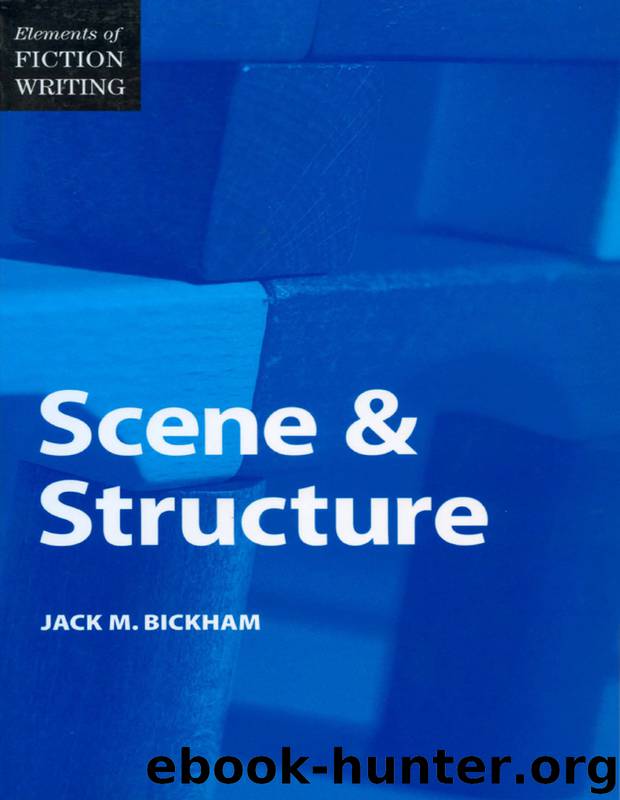Elements of Fiction Writing - Scene & Structure by Jack Bickham

Author:Jack Bickham [Bickham, Jack M.]
Language: eng
Format: epub, mobi
ISBN: 978-0-8987-9906-4
Publisher: F+W Media
Published: 1993-02-14T16:00:00+00:00
CHAPTER 9
VARIATIONS IN THE
INTERNAL
STRUCTURE OF SCENE
AND SEQUEL
ONE OF THE THINGS THAT MAKES IT devilishly difficult sometimes for an inexperienced fiction writer to see structural principles in action, in published copy, is the fact that there are so many possible deviations from the structural norm.
You have seen, for example, that the classic structure of the scene is goal … conflict … disaster in that order, with the bulk of the structure made up of the conflict component. You have also seen that the classic structure of sequel is emotion … thought … decision … action, also in that order. And although we’ve looked at methods of tinkering with the length or intensity of internal components for good reason, or even leaving out a part of a sequel, for example, for reasons of narrative pacing, we have not previously considered the possibility that parts might sometimes be presented out of their normal order for some good dramatic reason, or that other variations might occur such as a flashback scene that might “play” inside the thought compartment of a sequel, or a scene which might have so little time pressure on it that a viewpoint character’s momentary internalization takes on the structure of a full-fledged sequel right in the middle of things.
This is all difficult enough, but it’s just the tip of the iceberg. However, for you to understand more fully all the permutations of scene and sequel structure, it’s necessary to look at some of the more common deviations from the classic internal structure so that you can understand what’s going on as you analyze published work, and then expand your own arsenal of structural weapons.
Before wading into this morass of variations, however, let me restate two important points:
1. A novel can be successfully written in the straight, classic scene-and-sequel structure you now know, both in terms of the internal structure of each scene and sequel and in terms of the larger sequential structure into which the scenes and sequels are arranged, Scene #1 (classic pattern) being followed immediately by its Sequel #1 (classic pattern), followed by Scene #2 (classic pattern) followed by its Sequel #2 (classic pattern), and so on, all the way to the climax of the book.
What does this mean to you the author? Simply that you already know enough to produce a narrative structure that’s entirely salable in today’s markets.
2. If you have good plot reasons for doing so, you may depart from these classic structural patterns. But no matter how far you wind up straying, in the structure of your final manuscript, you should plan your story originally in classic scenes and sequels, arranged in the classic straight sequential pattern, with nothing skipped anywhere and no part of anything out of its normal order.
To put this another way, what I’m saying here is that you plan, basing your whole book’s architecture on Scene #1 – Sequel #1 – Scene #2 – Sequel #2 – Scene #3 – Sequel #3, etc., with every part in its natural order, nothing left out, and no variations of any kind.
Download
Elements of Fiction Writing - Scene & Structure by Jack Bickham.mobi
This site does not store any files on its server. We only index and link to content provided by other sites. Please contact the content providers to delete copyright contents if any and email us, we'll remove relevant links or contents immediately.
Asking the Right Questions: A Guide to Critical Thinking by M. Neil Browne & Stuart M. Keeley(5606)
Autoboyography by Christina Lauren(5174)
Eat That Frog! by Brian Tracy(4412)
Dialogue by Robert McKee(4311)
Sticky Fingers by Joe Hagan(4087)
Journeys Out of the Body by Robert Monroe(3557)
Annapurna by Maurice Herzog(3411)
Full Circle by Michael Palin(3365)
Schaum's Quick Guide to Writing Great Short Stories by Margaret Lucke(3305)
Elements of Style 2017 by Richard De A'Morelli(3300)
The Art of Dramatic Writing: Its Basis in the Creative Interpretation of Human Motives by Egri Lajos(3002)
The Diviners by Libba Bray(2872)
In Patagonia by Bruce Chatwin(2865)
Why I Write by George Orwell(2864)
Atlas Obscura by Joshua Foer(2852)
The Mental Game of Writing: How to Overcome Obstacles, Stay Creative and Productive, and Free Your Mind for Success by James Scott Bell(2837)
The Fight by Norman Mailer(2835)
Venice by Jan Morris(2513)
The Elements of Style by William Strunk and E. B. White(2432)
